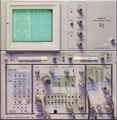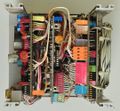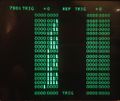7D01: Difference between revisions
m (Added link to local copy of Oct 1982 Instruction Manual) |
No edit summary |
||
| Line 15: | Line 15: | ||
* [[Media:Logic Analyzers Brochure 1976.pdf|Tektronix Logic Analyzers Brochure 1976 (PDF)]] | * [[Media:Logic Analyzers Brochure 1976.pdf|Tektronix Logic Analyzers Brochure 1976 (PDF)]] | ||
}} | }} | ||
The '''Tektronix 7D01''' is a logic analyzer plug-in for the [[7000-series scopes]]. Compatible extension modules | The '''Tektronix 7D01''' is a logic analyzer plug-in for the [[7000-series scopes]]. | ||
include the [[DF1]] and [[DF2]] display formatters and the [[DL2]] or [[DL502]] latch (glitch detector). The 7D01 takes two [[P6451]] 8+1 channel probes. The 7D01 does not contain a microprocessor and is built entirely from off-the-shelf logic ICs. | Compatible extension modules include the [[DF1]] and [[DF2]] display formatters and the [[DL2]] or [[DL502]] latch (glitch detector). | ||
The 7D01 takes two [[P6451]] 8+1 channel probes. | |||
The 7D01 does not contain a microprocessor and is built entirely from off-the-shelf logic ICs. | |||
Project manager for the 7D01 was [[Murlan Kaufman]]. | |||
{{BeginSpecs}} | {{BeginSpecs}} | ||
Revision as of 15:00, 2 February 2021
Template:Plugin Sidebar 2 The Tektronix 7D01 is a logic analyzer plug-in for the 7000-series scopes. Compatible extension modules include the DF1 and DF2 display formatters and the DL2 or DL502 latch (glitch detector). The 7D01 takes two P6451 8+1 channel probes. The 7D01 does not contain a microprocessor and is built entirely from off-the-shelf logic ICs.
Project manager for the 7D01 was Murlan Kaufman.
Key Specifications
| Channels |
|
|---|---|
| Sampling Rate | 10 ns to 5 ms per sample (1—2—5) or external clock up to 50 MHz |
| Trigger Sources |
|
Notes
Note about external clock rates (from Jim Mauck):
When I was a Tek Service Technician I worked on the 7D01. For several years I tested every 7D01 I worked on (and that was a lot of them) with a 100 MHz external clock in 16 channel mode. I would use a DF2 and set it to reacquire continuously as long as the 7D01 memory was the same as the original data I stored into the DF2 memory. The analyzer would run for hours without error. The funny part is that it wasn't until I had been doing this for several years that I realized it wasn't specified to run at that frequency. I continued to test them that way even after I discovered my error. However the instrument exceeding the specifications might be due to the data source providing a generous setup and hold time relative to the active clock edge.













